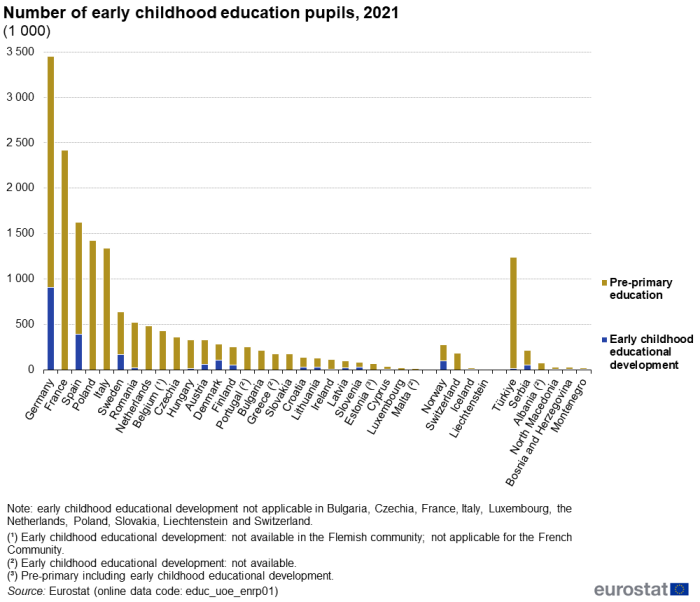Early childhood education statistics
Data extracted in November 2023.
Planned article update: September 2024.
Highlights
Around 15.4 million children were in early childhood education in the EU in 2021: 1.8 million were in early childhood educational development and 13.6 million in pre-primary education.
In the EU, 91.8 % of children aged between 3 years and the compulsory starting age for primary education were in early childhood education in 2021.

(%)
Source: Eurostat (educ_uoe_enra22)
This article presents statistics on early childhood education (ISCED level 0) in the European Union (EU) and forms part of an online publication on education and training in the EU. Early childhood education (ISCED level 0) is composed of early childhood educational development (category 010) and pre-primary education (category 020). These three categories should not be confused. Early childhood educational development is aimed at the youngest children (typically aged 0–3 years) while pre-primary education is designed for children aged 3 years until the starting age for primary education. This article uses education statistics from the UOE data collection – see the section on data sources below for more information. The data presented look at how many children in EU Member States are enrolled in early childhood education and give an indication as to financial and human resources committed to those programmes.
Early childhood education programmes are programmes for young children (under primary school age) that are considered to be educational according to the international standard classification for education (ISCED 2011). In these early years, before the age of entry to primary education, children are in their most formative years of life, where the foundations for lifelong habits and patterns are laid out. In order to be classified as educational, programmes for young children must be intentionally designed to support children's cognitive, physical and socio-emotional development. Activities considered as educational at this age will be very different to the traditional methods adopted within the context of compulsory schooling. Primary education starts at age 6 or 7 years in most EU Member States.
Early childhood education should not be confused with the broader term early childhood education and care (ECEC): the latter refers to any regulated arrangement for children from birth to compulsory primary school age, regardless of the programme content. ECEC encompasses not only early childhood education (ISCED level 0 programmes) but also programmes which do not meet the minimum requirements to be classified (such as childcare-only programmes).
Full article
Participation
Around 15.4 million children were in early childhood education in the EU in 2021: 1.8 million were in early childhood educational development and 13.6 million in pre-primary education. Differences in the number of children enrolled reflect the demographic structure of populations in different countries as well as differences in the age at which children start compulsory education. They also reflect country specific policies relating to ECEC systems.
- Bulgaria, Czechia, France, Italy, Luxembourg, the Netherlands, Poland, and Slovakia reported that there were no existing early childhood educational development programmes (ISCED 01). This was also the case in Liechtenstein and Switzerland among the non-EU countries included in Figure 1.
- By contrast, pre-primary education programmes existed in all countries included in Figure 1.
- Germany had the largest number of children in early childhood educational development (908 000), followed by Spain (389 000). Early childhood educational development also existed in Sweden, Denmark, Austria, Finland, Croatia, Slovenia, Lithuania, Latvia, Romania, Hungary, Cyprus, and Ireland.
- From all children in early childhood education, Denmark, Slovenia, Germany, Cyprus, and Sweden had, with more than 25 %, the highest shares of children in early childhood educational development (over 30 % in Denmark and Slovenia; 26 % in Germany, Cyprus, and Sweden). The lowest shares were reported in Hungary, Ireland, and Romania, where children in ISCED 01 made up less than 10 % of the overall population in early childhood education.
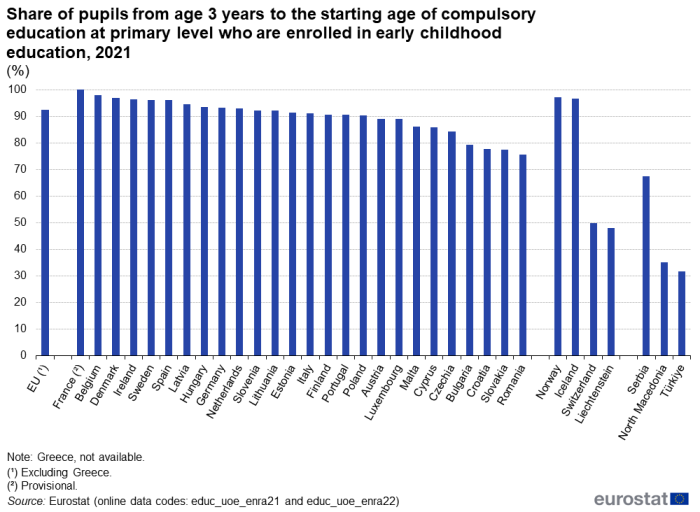
(%)
Source: Eurostat (educ_uoe_enra21) and (educ_uoe_enra22)
The European Education Area strategic framework set seven benchmarks to be met (across the whole of the EU) by 2025 or 2030. One of these is that at least 96 % of children between the age of 3 years and the starting age for compulsory primary education should participate in early childhood education.
Children in early childhood education from the age of 3 years until the starting age of compulsory primary education are typically enrolled in pre-primary programmes (ISCED level 0, category 020). The educational properties of pre-primary education are characterised by interaction with peers and educators, through which children improve their use of language and social skills, start to develop logical and reasoning skills, and talk through their thought processes. They are also introduced to alphabetical and mathematical concepts and are encouraged to explore their surrounding world and environment. Supervised gross motor activities (in other words physical exercise through games and other activities) and play-based activities can be used as learning opportunities to promote social interactions with peers and to develop skills, autonomy and school readiness.
As of 2021, the share of children in early childhood education between the ages of 3 years and the starting age for compulsory primary education was 92.5 % in the EU – see Figure 2. This is commonly referred to as the 3+ enrolment rate.
- The rate was below 80.0 % in Romania, Slovakia, Croatia and Bulgaria.
- This share was between 80.0 % and 90.0 % in five Member States and between 90.0 % and 95.0 % in 11 others.
- Shares equal to or above the 96 % policy target were observed in Spain (96.0 %), Sweden (96.1 %), Ireland (96.4 %), Denmark (97.0 %), Belgium (97.9 %) and France (100.0 %).
- Among the non-EU countries included in Figure 2, shares above the EU's policy target were observed in Iceland and Norway.
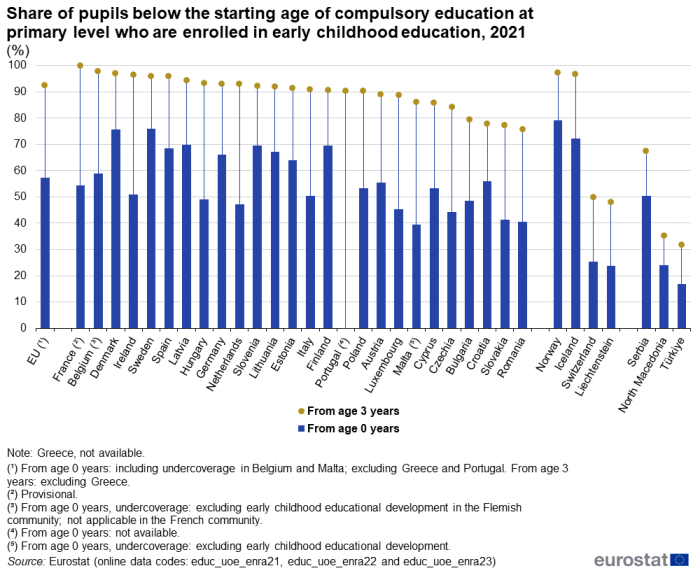
(%)
Source: Eurostat (educ_uoe_enra21), (educ_uoe_enra22) and (educ_uoe_enra23)
The bars in Figure 3 show the share of children from birth to the starting age for compulsory primary education who are in early childhood education (0+ enrolment rate). In 2021, 57.4 % of all children in the EU from birth to the starting age of compulsory primary education participated in early childhood education[1].
While children over the age of 3 years in early childhood education are typically enrolled in pre-primary education programmes (ISCED level 0, category 020), children in early childhood education from birth until the age of 3 years are typically enrolled in early childhood educational development programmes (ISCED level 0, category 010). The educational properties of early childhood educational development programmes are characterised by an emphasis on language acquisition and the use of language for meaningful communication as well as active play for exercising coordination and motor skills.
- In Sweden (76.0 %) and Denmark (75.7 %), just over three-quarters of children from birth to the starting age of compulsory primary education participated in early childhood education, the highest shares among the EU Member States.
- In 16 other Member States, a majority of children from age 0 to the starting age for compulsory primary education participated in early childhood education.
- In nearly all of the remaining Member States, between two-fifths and half of children from age 0 to the starting age for compulsory primary education participated in early childhood education.
The gold markers in Figure 3 also show – for comparison – the same data as in Figure 2, in other words, the 3+ enrolment rate. Big differences between the 0+ and the 3+ enrolment rates indicate a relatively low share of participation in early childhood education for children under the age of 3 years compared with the share of participation in early childhood education of children over the age of 3 years until the starting age of compulsory primary education. Countries that have big differences in the 0+ and 3+ enrolment rates are more likely to have split systems where childcare is the focus for younger children whereas education is the focus for older children in the years preceding primary education. Countries with smaller differences between the 0+ and 3+ enrolment rates are more likely to have more integrated systems where childcare and education are considered as inseparable and both are provided to all children, from birth to the starting age of compulsory primary education[2].
- Even though Croatia had a 3+ participation rate which was clearly below the EU average, the difference between the 0+ and the 3+ participation rates was only 22 percentage points (pp). It is considered an integrated system according to Eurydice analysis of ECEC systems.
- Even though the Netherlands, France, Ireland and Hungary had a 3+ participation rate which was above the EU average, the difference between their 0+ and 3+ participation rates was over 40 pp. These EU Member States are not considered as having integrated systems according to the Eurydice analysis referenced above.
The smallest differences between the 0+ and 3+ enrolment rates were in the Nordic Member States of Sweden, Finland and Denmark. Leaving aside Malta (for which the two indicators are not directly comparable), the largest difference was observed in the Netherlands.
Public and private early childhood educational development
The number of children enrolled in early childhood education programmes provided by public educational institutions can be compared with the number of children enrolled in early childhood education programmes provided by private but government-dependent educational institutions and private independent educational institutions. The UOE methodology makes the distinction between public and private based on whether a public agency or a private entity has the overall control of the institution and not according to which sector provides the majority of the funding[3]. If a private institution receives the majority of funding from a public agency it is considered to be a government-dependent private institution; if not, it is an independent private institution. Data distinguishing between children enrolled in public or private institutions are available for 25 EU Member States when looking at pre-primary (ISCED level 0, category 020) programmes. When looking at early childhood educational development (ISCED level 0, category 010), data are available for 16 Member States. In most Member States, the share of institutions which are private is higher for early childhood educational development than it is for pre-primary education. Figure 4 looks at early childhood educational development only.
- At least three-quarters of children in early childhood educational development were enrolled in public institutions in Romania, Estonia (covers also pre-primary education), Slovenia, Lithuania, Denmark, Croatia, Latvia, Sweden, Hungary and Finland.
- In Spain, the number of children in early childhood educational development institutions was quite evenly split between public and private sectors, with 53.8 % in public institutions.
- In Austria and Germany, enrolments in public and private institutions were both relatively large, but with a clear majority of children in early childhood educational development enrolled in private institutions: 59.6 % in Austria and 73.4 % in Germany.
- The vast majority of children in early childhood educational development were enrolled in private institutions in Cyprus (96.5 %); in Ireland, all children in early childhood educational development were enrolled in private institutions.

Source: Eurostat (educ_uoe_enrp01)
Resources – finance
Data on expenditure for education are compiled for financial years, rather than for academic years as is used for example for statistics on pupil enrolments. Various sources provide funding for education, notably government (public sources), the non-educational private sector (households and other private entities) and international organisations. See the article on educational expenditure statistics for more information. The sum of the expenditure by each of the sources may exceed the total expenditure because of transfers between sources. The shares for each source presented in Figure 5 and described here are calculated as the share of each source within the sum for all sources.
In all EU Member States for which data are available (see Figure 5 for details), the financial resources devoted to early childhood education came mainly from government. This public expenditure share ranged in 2020 from 63.2 % in Portugal to a range of 96.5 % to 96.7 % in Belgium (note the undercoverage), Romania and Luxembourg.
Expenditure from the non-educational private sector includes, for example, expenditure on enrolment fees, material costs and the cost of school meals. This sector accounted for 0.5 % of expenditure on early childhood education in 2020 in Romania and less than one-fifth in 19 other EU Member States. The non-educational private sector contributed between one-fifth and one-quarter of all expenditure on early childhood education in Spain, Croatia and Denmark, and between one-third and two-fifths of the total in Cyprus (33.8 %) and Portugal (36.8 %; note the undercoverage).
International organisations accounted for a relatively small share of expenditure on early childhood education in 2020 in all of the EU Member States. Their share was highest in Slovakia (5.0 %) but was 0.0 % in 14 Member States; this was also the case for all of the non-EU countries shown in Figure 5.
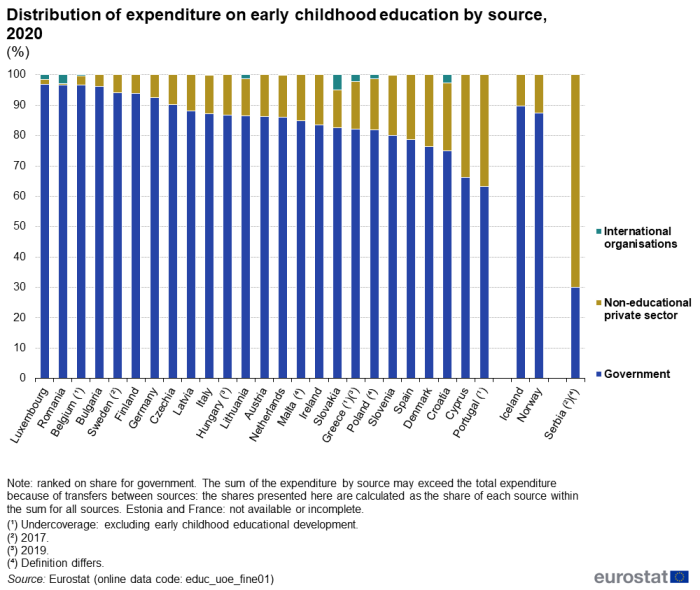
(%)
Source: Eurostat (educ_uoe_fine01)
Resources – staff
The child–staff ratio in early childhood education is calculated by dividing the number of children enrolled in ISCED level 0 by the number of full-time equivalent staff members (teachers plus teachers' aides) at the same level – see online table on the Ratio of pupils to teachers and teacher aides by education level and programme orientation (educ_uoe_perp05). The EU quality framework for ECEC states that higher staff ratios (more staff per group of children) are more likely to facilitate positive and responsive interactions among adults and children[4]. In the 17 EU Member States for which data for 2021 are available, child-staff ratios ranged from 3.8 children per member of staff to 13.8. There were less than 6.0 children per member of staff in Ireland, Denmark, Sweden and Malta, and there were more than 13.0 children per member of staff in the Netherlands, France and Romania.
It should be noted that the requirement for staff to have pedagogical qualifications is only a subsidiary criterion for programmes to be classified as early childhood education, which means that most, but not all, programmes have pedagogically trained staff.
Figure 6 looks at the numbers of men and women who are teachers in early childhood education. It presents information only for teachers, rather than all staff (teachers and teachers' aides) because such data are available for more EU Member States[5]. Note that teachers in early childhood education are individuals with the most responsibility for a group of children at the class – or playroom – level and may be referred to as pedagogues, educators or childcare practitioners at this level of education.
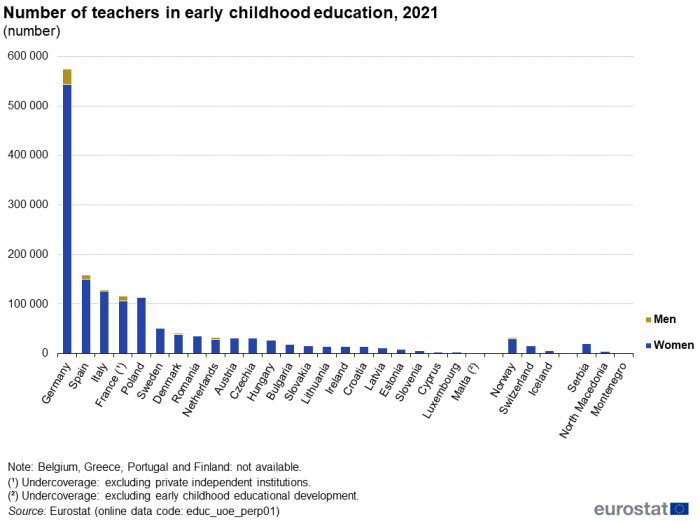
(number)
Source: Eurostat (educ_uoe_perp01)
There was a large imbalance between the numbers of male and female teachers at this educational level: men accounted for 4.5 % of all early childhood education teachers in the EU. In eight of the 25 EU Member States for which the number of teachers in early childhood education is available (no data for Portugal or Finland; 2019 data for Greece), the share of men in the total number of teachers was less than 1.0 %. The share was between 5.0 % and 10.0 % in five Member States and peaked at 11.9 % in the Netherlands.
Source data for tables and graphs
Data sources
Source
The standards for international statistics on education are set by three international organisations: the United Nations Educational, Scientific, and Cultural Organization (UNESCO) institute for statistics (UIS); the Organisation for Economic Co-operation and Development (OECD); Eurostat, the statistical office of the EU.
The source of data used in this article is a joint UNESCO/OECD/Eurostat (UOE) data collection on education statistics and this is the basis for the core components of Eurostat's database on education statistics; in combination with the joint data collection, Eurostat also collects data on regional enrolments and foreign language learning. More information about the joint data collection is available in an article on the UOE methodology.
Classification
The international standard classification of education (ISCED) is the basis for international education statistics, describing nine different levels of education.
Key concepts
Child–staff ratios are calculated by dividing the number of full-time equivalent children in each level of education by the number of full-time equivalent staff members at the same level. This ratio should not be confused with average class/group size, which refers to the number of children in a given course or room.
Context
In May 2019, the Council of the European Union adopted recommendations for High-Quality Early Childhood Education and Care Systems. This underlined the importance of early childhood education. It noted that returns on investment in early stages of education are the highest of all educational stages, particularly for children in a disadvantaged situation. With respect to quality, it noted that evidence shows that only high-quality early childhood education and care services deliver benefits; low quality services have [a] significant negative impact on children and on society as a whole.
UOE data can be used to give an indication as to certain aspects of quality in such programmes: the level of integration of systems for childcare and education; the public/private shares of early childhood education services; the child-staff ratio; and the gender balance of staff.
Direct access to
Notes
- ↑ As noted in the Council Recommendation of May 2019 on High-Quality Early Childhood Education and Care Systems, learning and education do not begin with compulsory schooling or from the age of 3 years – they start from birth.
- ↑ The May 2019 Council recommendation on high-quality ECEC systems state that provision is best designed when it is based on the fundamental assumption that education and care are inseparable.
- ↑ The UOE manual.
- ↑ The framework also acknowledges that no-single component of structural quality associated with working conditions has – on its own – a significant impact on ECEC quality. It is the combination of several components – related to staff working conditions – that produces ECEC quality. And a different balance is needed in different countries.
- ↑ In terms of the gender balance of staff in early childhood education, the 2019 Council Recommendation on High-Quality Early Childhood Education and Care Systems recommends that EU Member States support the professionalisation of early childhood education and care staff in a number of ways, including by striving to achieve a better gender balance.
- Participation in education and training (educ_part)
- Education personnel (educ_uoe_per)
- Education finance (educ_uoe_fin)
Metadata
- Pupils and students - enrolments (ESMS metadata file – educ_uoe_enr_esms)
Manuals and other methodological information
- International Standard Classification of Education (ISCED) 2011
- ISCED 2011 Operational Manual – Guidelines for classifying national education programmes and related qualifications
- UOE data collection on formal education – Manual on concepts, definitions and classifications – 2022 edition
- UNESCO OECD Eurostat (UOE) joint data collection – methodology
- Regulation (EC) No 452/2008 of 23 April 2008 concerning the production and development of statistics on education and lifelong learning
- Commission Regulation (EU) No 912/2013 of 23 September 2013 as regards statistics on education and training systems
- Summaries of EU Legislation: statistics on education and lifelong learning
- European Education and Culture Executive Agency (EACEA), see:
- European Commission – European Education Area – Strategic framework for European cooperation in education and training towards the European Education Area and beyond (2021–2030)
- European Commission – European Education Area – School education initiatives, see:
- OECD – Education, see:
- UNESCO – Education transforms lives, see:
